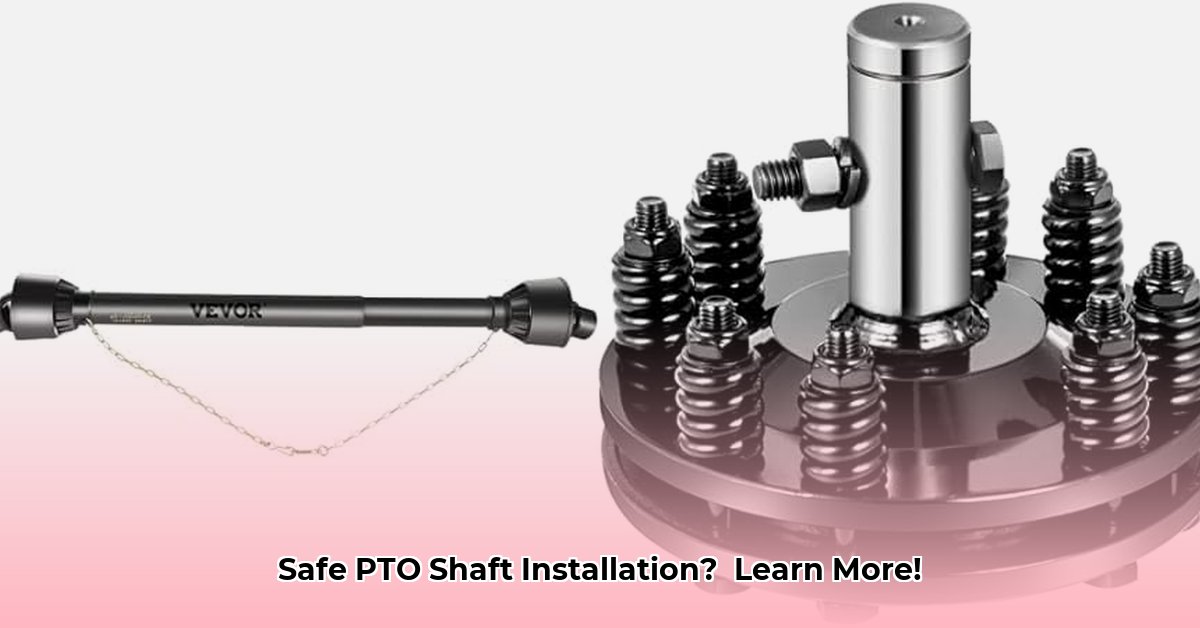
Understanding Your PTO Shaft: More Than Just a Metal Rod
Your PTO shaft (Power Take-Off shaft) is the critical link transferring power from your tractor's engine to your Bush Hog rotary cutter. It's more than just a simple metal rod; it's a vital component ensuring safe and efficient operation. A poorly chosen or poorly maintained PTO shaft can lead to serious damage and injury. Understanding its function and proper maintenance is crucial for maximizing its lifespan and ensuring the safety of your equipment and yourself. This section outlines the key factors to consider when working with your PTO shaft, and how to maximize your agricultural work. For more information on tractor attachments, check out this helpful resource: Grass Cutter Attachments.
Picking the Right PTO Shaft: Size Really Does Matter
Selecting the correct PTO shaft length is paramount. An improperly sized shaft can lead to dangerous situations. A shaft too short will bind, causing excessive stress and potential damage. Conversely, a shaft that's too long risks a dangerous whipping action, posing a significant safety hazard. Accurate measurement is essential.
Begin by precisely measuring the distance between your tractor's PTO output and your Bush Hog's input. Always consult your tractor and Bush Hog owner's manuals for the recommended length for your specific models. These manuals provide crucial information for ensuring compatibility and safety. Never rely on estimations; precision is key in this process. Ignoring this could damage your equipment or cause injury!
Here's a sample table to illustrate typical PTO shaft lengths; however, always prioritize the specifications found in your owner's manuals.
| Tractor Model | Bush Hog Model | Recommended PTO Shaft Length (feet) | Notes |
|---|---|---|---|
| John Deere 4020 | Bush Hog 280 | 6 | May vary slightly depending on specific models |
| Massey Ferguson 135 | Bush Hog 150 | 5 | Check for variations based on accessories |
| Ford 8N | Bush Hog 180 | 5.5 | Always confirm length in your manual |
| Kubota BX23S | Bush Hog 170 | 4.5 | Length might be affected by mounting position |
Beyond length, consider the shaft's diameter and the type of universal joints (U-joints) used. These specifications are unique to your tractor and Bush Hog and must match precisely to avoid significant vibrations, poor performance, and premature wear. Refer to your manuals for these crucial details.
Installing Your PTO Shaft Safely: A Step-by-Step Guide
Correct PTO shaft installation is critical for safety and efficient operation. Incorrect installation can lead to serious damage and injury. Follow these steps meticulously:
Power Down: Before beginning any work, always ensure your tractor is completely shut off and the PTO is disengaged. This is a non-negotiable safety precaution.
Align and Connect: Carefully align the PTO shaft's ends with your tractor's PTO output and the Bush Hog's input. Ensure a precise fit; this is crucial for proper operation and preventing damage.
Secure Connections: Use the correct clamps and locking mechanisms provided with your equipment. Never use substitutes. Double-check all connections to ensure they are secure and tightened properly.
Visual Inspection: Conduct a thorough visual inspection of the entire setup. Verify that everything is in place and there are no loose components or signs of damage.
Test Run (Short and Cautious): Start the tractor and engage the PTO slowly. Listen and watch carefully for any unusual noises or vibrations. If everything seems normal, proceed with operation.
Maintaining Your PTO Shaft: Preventative Care Saves Money
Regular maintenance is key to extending your PTO shaft's lifespan and preventing costly repairs. Small preventative measures can save significant time and money in the long run. Here's what you should prioritize:
Lubrication: Keep the universal joints well-lubricated to reduce friction and wear. Follow the lubrication schedule and recommendations specified in your owner's manual.
Visual Inspections: Regularly inspect the shaft for bends, cracks, or excessive wear. Early detection is essential for preventing more significant problems.
Tightness Checks: Periodically check all clamps and connections to ensure everything remains securely fastened. Loose connections are a common source of vibrations and potential failure.
Troubleshooting Common Issues: Addressing Problems Effectively
Even with proper installation and maintenance, problems can occur. Here are some common issues and how to address them:
Excessive Vibrations: This often indicates a bent shaft, worn U-joint, or loose connection. Inspect each component carefully to identify the source.
Binding or Sticking: Binding usually means the shaft is too short, misaligned, or encountering obstructions. Verify shaft length, alignment, and clearance.
Complete Failure to Operate: If the shaft isn't turning, check your tractor's PTO engagement and then carefully inspect all connections and components.
If you are uncomfortable tackling these troubleshooting steps, seek professional help from a qualified mechanic.
Key Takeaways:
- Proper PTO shaft selection and installation are crucial for safe and efficient operation.
- Regular maintenance significantly extends the life of your PTO shaft and prevents costly repairs.
- Addressing problems promptly can prevent minor issues from escalating into costly repairs.
Remember, prioritizing safety is essential when working with agricultural equipment. By following these guidelines, you can ensure the reliable performance of your PTO shaft and your Bush Hog rotary cutter for years to come.